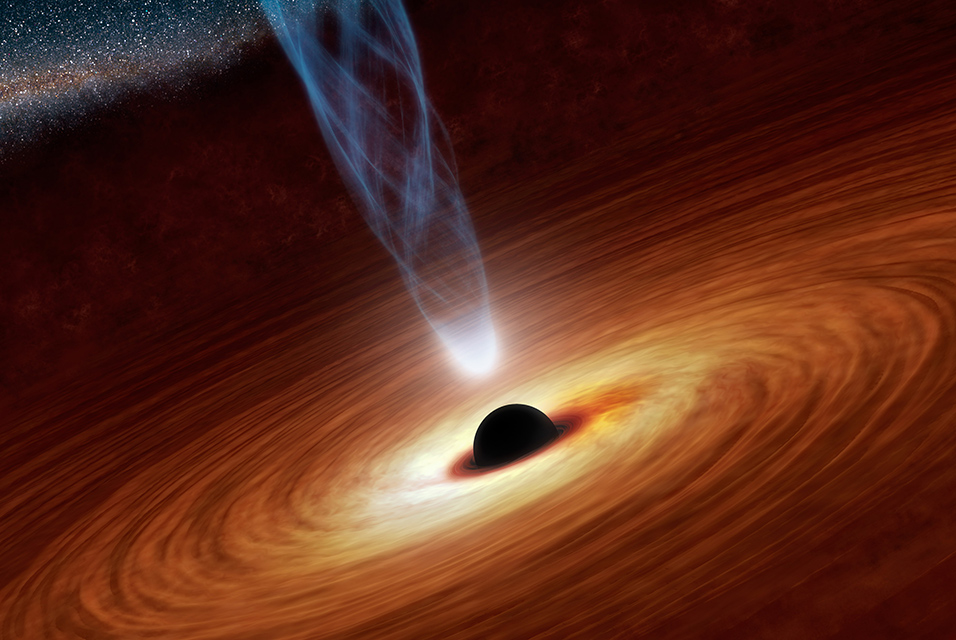CORAL GABLES, FL.- Proposing an alternative model for how the universe came to be, a team of astrophysicists suggests that all black holes—from those as tiny as a pin head to those covering billions of miles—were created instantly after the Big Bang and account for all dark matter.
That’s the implication of a study by astrophysicists at the
University of Miami, Yale University, and the European Space Agency that suggests that black holes have existed since the beginning of the universe and that these primordial black holes could be as-of-yet unexplained dark matter. If proven true with data collected from this month’s launch of the James Webb Space Telescope, the discovery may transform scientific understanding of the origins and nature of two cosmic mysteries: dark matter and black holes.
“Our study predicts how the early universe would look if, instead of unknown particles, dark matter was made by black holes formed during the Big Bang—as Stephen Hawking suggested in the 1970s,” said Nico Cappelluti, an assistant professor of physics at the University of Miami and first author of the study slated for publication in The Astrophysical Journal.
“This would have several important implications,” continued Cappelluti, who this year expanded the research he began at Yale as the Yale Center for Astronomy and Astrophysics Prize Postdoctoral Fellow. “First, we would not need ‘new physics’ to explain dark matter. Moreover, this would help us to answer one of the most compelling questions of modern astrophysics: How could supermassive black holes in the early universe have grown so big so fast? Given the mechanisms we observe today in the modern universe, they would not have had enough time to form. This would also solve the long-standing mystery of why the mass of a galaxy is always proportional to the mass of the super massive black hole in its center.”
Dark matter, which has never been directly observed, is thought to be most of the matter in the universe and act as the scaffolding upon which galaxies form and develop. On the other hand, black holes, which can be found at the centers of most galaxies, have been observed. A point in space where matter is so tightly compacted, they create intense gravity.
Co-authored by Priyamvada Natarajan, professor of astronomy and physics at Yale, and Günther Hasinger, director of science at the European Space Agency (ESA), the new study suggests that so-called primordial black holes of all sizes account for all black matter in the universe.
“Black holes of different sizes are still a mystery,” Hasinger explained. “We don’t understand how supermassive black holes could have grown so huge in the relatively short time available since the universe existed.”
Their model tweaks the theory first proposed by Hawking and fellow physicist Bernard Carr, who argued that in the first fraction of a second after the Big Bang, tiny fluctuations in the density of the universe may have created an undulating landscape with “lumpy” regions that had extra mass. These lumpy areas would collapse into black holes.
That theory did not gain scientific traction, but Cappelluti, Natarajan, and Hasinger suggest it could be valid with some slight modifications. Their model shows that the first stars and galaxies would have formed around black holes in the early universe. They also propose that primordial black holes would have had the ability to grow into supermassive black holes by feasting on gas and stars in their vicinity, or by merging with other black holes.
“Primordial black holes, if they do exist, could well be the seeds from which all the supermassive black holes form, including the one at the center of the Milky Way,” Natarajan said. “What I find personally super exciting about this idea is how it elegantly unifies the two really challenging problems that I work on—that of probing the nature of dark matter and the formation and growth of black holes—and resolves them in one fell swoop.”
Primordial black holes also may resolve another cosmological puzzle: the excess of infrared radiation, synced with X-ray radiation, that has been detected from distant, dim sources scattered around the universe. The study authors said growing primordial black holes would present “exactly” the same radiation signature.
And, best of all, the existence of primordial black holes may be proven—or disproven—in the near future, courtesy of the Webb telescope scheduled to launch from French Guiana before the end of the year and the ESA-led Laser Interferometer Space Antenna (LISA) mission planned for the 2030s.
Developed by NASA, ESA, and the Canadian Space Agency to succeed the Hubble Space Telescope, the Webb can look back more than 13 billion years. If dark matter is comprised of primordial black holes, more stars and galaxies would have formed around them in the early universe, which is precisely what the cosmic time machine will be able to see.
“If the first stars and galaxies already formed in the so-called ‘dark ages,’ Webb should be able to see evidence of them,” Hasinger said.
LISA, meanwhile, will be able to pick up gravitational wave signals from early mergers of primordial black holes.









